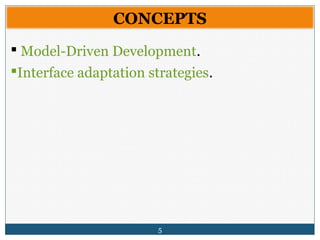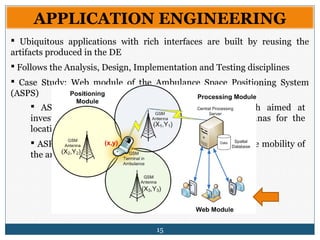Model driven RichUbi: a model driven process for building rich interfaces of context-sensitive ubiquitous applications
- 1. FEDERAL UNIVERSITY OF SÃO CARLOS CENTER OF SCIENCES AND TECHNOLOGY GRADUATE PROGRAM IN COMPUTER SCIENCE Carlos Eduardo Cirilo Antonio Francisco do Prado Wanderley L. de Souza Luciana Aparecida Martinez Zaina MODEL DRIVEN RICHUBI - A MODEL DRIVEN PROCESS FOR BUILDING RICH INTERFACES OF CONTEXT-SENSITIVE UBIQUITOUS APPLICATIONS Software Engineering Group 1 Available in: http://dx.doi.org/10.1145/1878450.1878485
- 2. 2 MOTIVATION Rich interfaces • The main proposal is to provide the user with a rich interaction o Rich interface components: multimedia, drag & drop, sliding panels, auto-completion fields, online spreadsheets, etc... • Better responsiveness and performance o Asynchronous communication o Avoid unnecessary page reloads • Better user interaction (facilitates and motivates)
- 3. 3 MOTIVATION Ubiquitous Computing Computing has enabled users easy access to services and applications from anywhere, anytime, and using any device. Heterogeneity of access devices Need to adapt applications’ interfaces
- 4. 4 GOALS OF THIS PAPER To define a model-driven process (Model Driven RichUbi) Support to the development of rich interfaces of context- sensitive ubiquitous applications Based on the conceptions of Domain-Specific Modeling (DSM) Interfaces modeling based on a rich interface components metamodel Hides low level details Facilitates communication between users and developers Users can understand technical issues better and suggest improvements directly on the conceptual level Partial code generation to different platforms Development of code generators and dynamic content adapters
- 5. 5 CONCEPTS Model-Driven Development. Interface adaptation strategies.
- 6. 6 MODEL-DRIVEN DEVELOPMENT Focuses on models instead of source code Raises the level of abstraction during the development Applies appropriate model-to-code (M2C) transformations to generate the entire or most of the code for different platforms The methodology to user interface: Model-Based User Interface Development : Definition of the different aspects of user interfaces (presentation, dialog, user tasks structure) in an abstract way, regardless the implementation platform
- 7. 7 MODEL-DRIVEN DEVELOPMENT Domain Specific Modeling (DSM) Models are built by using Domain Specific Languages (DSLs), which can be defined through metamodels that represent the knowledge of a particular domain Reduces the effort in translating the concepts of problem domain into concepts of the solution domain The interface models are created in a more intuitive way and are less associated with the technical details of implementation
- 10. 10 MODEL DRIVEN RICHUBI MDD (DSM) Rich Interfaces Focuses on rich interface domain in order to support the development of rich interfaces for different platforms Modeling is performed from a rich interface components metamodel Employs a hybrid adaptation strategy: Requirements are mapped into a few generic interface versions, each being appropriate for a particular group of devices (static adaptation) Dynamic content adapters allow, at runtime, to select the version that best fits the device profile, and to adapt the code snippets to meet the characteristics of the access device (dynamic adaptation)
- 11. 11 MODEL DRIVEN RICHUBI Process Overview
- 12. 12 DOMAIN ENGINEERING Construction of the Rich Interface Components Metamodel The requirements of rich interface domain are elicited, specified, analyzed and represented in a rich interface components metamodel Interface components identified in environments of Web development (Dreamweaver, MS Visual Studio)
- 13. 13 DOMAIN ENGINEERING Construction of the Model to Code Transformations The transformations that will be applied to the interface models for code generation during the AE step are built Construction of Content Adapters Building of the content adapters that will accomplish the dynamic adaptation of the interface components according to the device profile during the application execution
- 14. 14 MODEL DRIVEN RICHUBI Process Overview
- 15. 15 APPLICATION ENGINEERING Ubiquitous applications with rich interfaces are built by reusing the artifacts produced in the DE Follows the Analysis, Design, Implementation and Testing disciplines Case Study: Web module of the Ambulance Space Positioning System (ASPS) ASPS emerged from an experimental study which aimed at investigating the use of the signals from GSM antennas for the location of people or objects ASPS allows the fleet management team to monitor the mobility of the ambulances
- 16. 16 APPLICATION ENGINEERING Design ASPS specifications refinement Modeling of the application interfaces as an instance of the metamodel
- 17. 17 APPLICATION ENGINEERING Implementation and Testing Partial code generation from modeling by using the M2C transformations Content adapter reuse
- 18. 18 CONCLUSIONS AND FURTHER WORK Main contributions Study and research on the use of DSM for building rich interfaces of context-sensitive ubiquitous applications; Specification of a rich interface components metamodel and M2C transformations to support the modeling and code generation for different platforms; and Content adaptation carried out in a hybrid fashion with the use of context. Future Work Addition of new rich interface components to the metamodel; Construction of a graphical notation for the metamodel in order to turn modeling more user-friendly; and Optimizations in the M2C transformations that allow further automation of code generation.
- 19. 19 Thank you! Carlos E. Cirilo [email protected] Antonio F. Prado [email protected] Luciana A. M. Zaina [email protected] http://www.ges.dc.ufscar.br Wanderley L. de Souza [email protected]
Editor's Notes
- #3: The Rich interfaces main proposal is to provide the user with a rich interaction. A imagem mostra um exemplo de interface rica, com recursos auto-completar (campo para busca de músicas no canto superior direito), componente de reprodução de áudio e vídeos, painel de abas (menu superior), e leiaute rico. No campo de busca de músicas, à medida que o usuário insere valores no campo, requisições assíncronas são enviadas ao servidor e retornadas as sugestões ao usuário, sem que o mesmo tenha que aguardar a resposta (ou seja, ele continua interagindo com a aplicação mesmo enquanto sua requisição está sendo processada – modelo assíncrono de comunicação – uso de AJAX).
- #4: Ubiquitous Computing has enabled users easy access to services and applications from anywhere, anytime, and using any device.
- #5: Pelo fato de os modelos (nos quais os requisitos da aplicação são mapeados em componentes de interfaces) serem elaborados na mesma linguagem e jargão do domínio, a comunicação entre os usuários e os desenvolvedores torna-se simplificada (o usuário sabe que o requisito X foi mapeado para o componente painel de aba, por exemplo). Os usuários podem sugerir melhorias diretamente nos modelos. Posteriormente, qdo o modelo tiver completo, aplica-se as transformações modelo-para-código apropriadas (geradores de código), para gerar versões estáticas da interface para diferentes tecnologias. Com o uso dos adaptadores dinâmicos de conteúdo desenvolvidos no processo é possível identificar o dispositivo de acesso, escolher a versão mais apropriada da interface para aquele dispositivo, e refina-la ainda mais conforme as peculiaridades do dispositivo de acesso identificado.
- #6: Pelo fato de os modelos (nos quais os requisitos da aplicação são mapeados em componentes de interfaces) serem elaborados na mesma linguagem e jargão do domínio, a comunicação entre os usuários e os desenvolvedores torna-se simplificada (o usuário sabe que o requisito X foi mapeado para o componente painel de aba, por exemplo). Os usuários podem sugerir melhorias diretamente nos modelos. Posteriormente, qdo o modelo tiver completo, aplica-se as transformações modelo-para-código apropriadas (geradores de código), para gerar versões estáticas da interface para diferentes tecnologias. Com o uso dos adaptadores dinâmicos de conteúdo desenvolvidos no processo é possível identificar o dispositivo de acesso, escolher a versão mais apropriada da interface para aquele dispositivo, e refina-la ainda mais conforme as peculiaridades do dispositivo de acesso identificado.
- #11: A parte da adaptação estática é facilitada com a geração de código a partir da modelagem para diferentes tecnologias (através do reúso do metamodelo e das transformações M2C) A parte da adaptação dinâmica é facilitada com o emprego dos adaptadores de conteúdo (através do reúso desses componentes)
- #12: O processo é dividido nas etapas de ED e EA. Na ED constóem-se os artefatos para reúso (metamodelo, transformações M2C, e adaptadores de conteúdo). A EA constóem-se as interfaces ricas das aplicações ubíquas sensíveis ao contexto com o reúso dos artefatos previamente construídos na ED. Esses artefatos podem ser reutilizados em diferentes projetos na etapa de EA.
- #13: A figura mostra um exemplo de especificação dos componentes de interface. À esquerda o diagrama de classes especificando alguns dos componentes de interface que foram identificados a partir de ambientes de desenvolvimento Web (Dreamweaver, MS VisualStudio...). À direita tem-se a representação dos componentes (em azul) no metamodelo extraídos a partir do diagrama de classes. O metamodelo foi especificado utilizando o Eclipse Modeling Framework (EMF).
- #14: Pode-se criar transformações que geram código para diferentes tecnologias a partir do mesmo modelo (ex: XHTML para desktops e smartphones, WML, VoiceXML, HTML5 etc...) Template JET para a geração do código do componente de inerface rica TabbedPanel. Uso das funções da biblioteca jQuery para renderizar o painel de abas na saída (linhas 2-4), e uso de folhas de estilo pré-fabricadas para pré-formatação do leiaute da interface (atributo class da tag div na linha 6). As transformações também foram incorporadas à ferramenta MVCASE para suporte à geração de código na EA.
- #15: O processo é dividido nas etapas de ED e EA. Na ED constóem-se os artefatos para reúso (metamodelo, transformações M2C, e adaptadores de conteúdo). A EA constóem-se as interfaces ricas das aplicações ubíquas sensíveis ao contexto com o reúso dos artefatos previamente construídos na ED. Esses artefatos podem ser reutilizados em diferentes projetos na etapa de EA.
- #17: A figura ilustra como é feito o mapeamento dos requisitos para componentes de interface no modelo que satisfação esses requisitos. É ilustrado também a forma com que o metamodelo está sendo instanciado no backend.



















